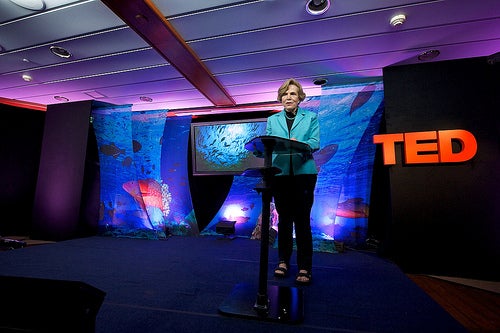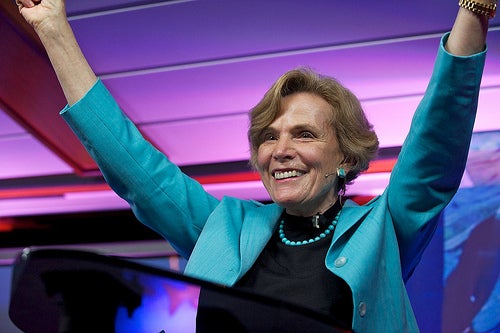
Sylvia Earle dives into all things blue. She moves equally well through conversations on ocean technology, ocean politics, ocean lifestyle, ocean science, and ocean exploration. In 1966, received her for a study of aquatic plant life in the Gulf of Mexico. Since then, a series of accomplishments has put her at the top of a pile of scientific explorers. Here are just a few of those accomplishments: living underwater for two weeks on the Tektite II mission, walking on the seafloor at a depth lower than any other woman, building revolutionary subs with fellow explorer , working as the chief scientist at NOAA, and teaming up with Google to allow anyone with a laptop to .
Most recently, Earle has been in the news for . She used that platform to make a wish to improve the state of the world's oceans.
“I wish you would use all means at your disposal — films! expeditions! the web! more! — to ignite public support for a global network of marine protected areas, Hope Spots large enough to save and restore the ocean, the blue heart of the planet.”

We spoke to Dr. Earle about her TED Prize, Mission Blue, and what she thinks of the recent Gulf of Mexico oil spill. A fitting topic, not only because it's the most recent environmental disaster facing the ocean, but because the Gulf is where Dr. Earle started her journey.
Below are some edited excerpts, stamped with time quotes. You can download the full podcast by clicking on the link at the bottom of this post.
Her TED Wish for Hope Spots 1:30
It was an easy decision for me to zero in on the importance of having Marine Protected Areas, that I think of as Hope Spots, because there is such need to stabilize and restore health to the ocean. To me, Hope Spots are equivalent to National Parks on land, only with a more urgent need to get serious about underwriting these natural systems that keep us alive. Without the ocean, there is no life on earth.
On Mission Blue 13:40
I think the big news is that people from many disciplines really came together with a common purpose—to do everything that they could to make a difference during this time of crises for the ocean. Some came with music. There was Jackson Browne, and Damien Rice. The film team from the Cove came to document the action. Their next big project is to do something about Hope Spots. There were 25 speakers charged with making the talk of their life. That's what TED does. You had Edith Whidder, who is a deep sea explorer and biologist whose specialty is bioluminescence, that had everyone dazzled with life in the deap sea. You had a wonderful talk about the wily ways of octupus and squid by Mike DeGruy. (Watch the participants' talks on the .)
Education 16:00
There's something missing about how we're informing the youngsters coming along about what matters in the world. We teach them the numbers and the letters, but we fail to communicate the importance of our connection to the living world.
The Deepwater Horizon Disaster in the Gulf of Mexico 21:00
It's a two-by-four. It causes people to be aware that problems can arise suddenly, where for decades it can seem that the problems had been solved. In this case, oil spills associated with drilling were thought to basically be a thing of the past. Because of the blowout preventers and other technologies that have been used by the industry, especially by U.S. oil companies, I think a kind of complacency had set in, with the focus more on the shipping of oil… But now we know that we can't just be complacent about the drilling operations anymore. We've got graphic evidence that accidents do and will happen even with the best intentions and best technologies that we so far have applied. I think it will shape future policies about allowing drilling to take place in sensitive areas.
For more on Mission Blue, go to .
(Our apologies that this interview is a little rough. We'll have a better player and improved sound on the next few. We promise.)
–Joe Spring